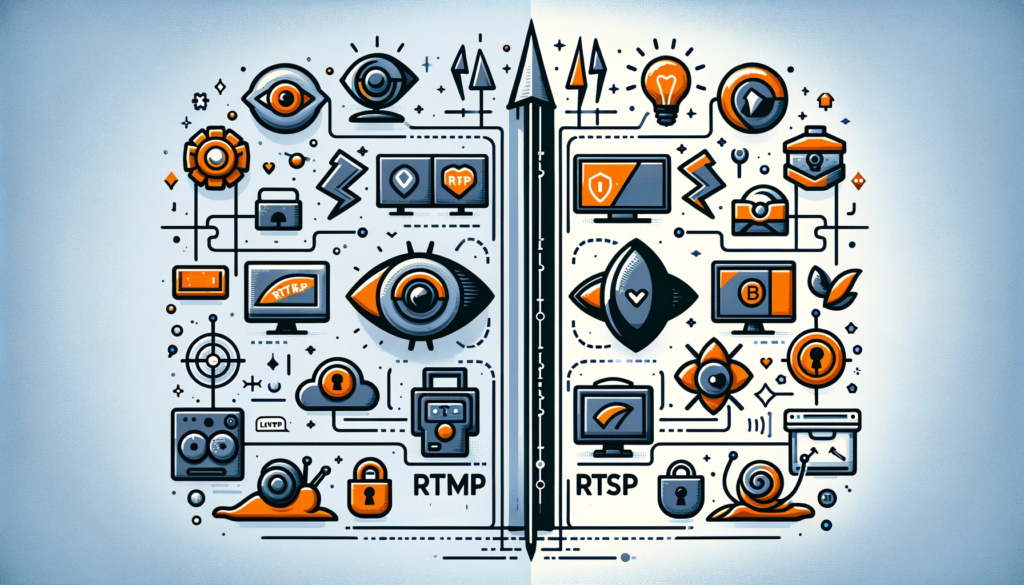In this blog, we’ve examined RTMP (Real-Time Messaging Protocol) and RTSP (Real-Time Streaming Protocol) to discover that RTMP stands out for its low latency, and real-time video streaming, making it ideal for social media and live platforms. Conversely, RTSP excels in controlling streaming media, such as in surveillance systems, focusing on media stream management rather than mere transmission.
We’ve compared RTMP and RTSP operational methods, benefits, limitations, and unique features like encryption and packet structures. This analysis highlights each protocol’s suitability for different streaming scenarios. Accompanying this is an infographic visually contrasting RTMP’s strengths in live streaming against RTSP’s capabilities in media control, providing a clear, at-a-glance comparison of the two protocols. This exploration offers essential insights into the roles and relevance of RTMP and RTSP in various streaming contexts.
Table of Contents:
- What is RTSP?
- How Does RTSP Work?
- Benefits of RTSP
- Cons of RTSP
- Key Components of RTSP
- History and Development of RTSP
- What is RTMP?
- How Does RTMP Work?
- Benefits of RTMP
- Cons of RTMP
- Encryption
- HTTP Tunneling
- Packet Structure
- Software Implementations
- RTMP Protocol
- History and Development
- RTMP vs RTSP Comparison Summary
- References
What is RTSP?
Real-Time Streaming Protocol (RTSP) is an application-level network communication system used for transferring real-time data from multimedia sources to an endpoint device by directly communicating with the server streaming the data.
It is an application-level network protocol designed for multiplexing and packetizing multimedia transport streams, such as interactive media, video, and audio, over a suitable transport protocol. RTSP is employed in entertainment and communication systems to control streaming media servers, establishing and controlling media sessions between endpoints. Notably, RTSP does not stream multimedia itself but communicates with the server that streams the multimedia data.
How Does RTSP Work?
RTSP allows a client device to send an RTSP request to the server to determine options like pause, play, and record. The server returns a list of request types it can accept through RTSP. The client then sends a media description request, and the server responds with a description of the media. A setup request follows, and the server responds with transport mechanism information. Once the setup is complete, the client initiates the streaming process.
VdoCipher helps several VOD and OTT Platforms to host their videos securely, helping them to stop losing their video revenues.
Benefits of RTSP
RTSP is beneficial in scenarios where real-time control and manipulation of streaming media are required. It allows for commands like play, record, and pause, facilitating real-time control of media streaming.
Cons of RTSP
The transmission of streaming data itself is not a task of RTSP, which could be considered a limitation. Most RTSP servers use the Real-time Transport Protocol (RTP) in conjunction with Real-time Control Protocol (RTCP) for media stream delivery, but some vendors implement proprietary transport protocols.
Key Components of RTSP
RTSP has several key components, such as:
- Options: Determines the request types the media server supports.
- Describe: Includes a URL and describes the replay data.
- Setup: Describes how to transport the bitstream.
- Teardown: Ends the streaming media session.
- Redirect: Directs the client to connect to a different media server.
- Play: Starts the specified media.
- Pause: Freeze the specified media until resumed.
- Record: Starts a recording of the media.
- Set_Parameter: Tests client or server activity and reveals values of presentation or stream guidelines.
Sample code for some of these components includes:
- Options:
yaml
-
C->S: OPTIONS rtsp://example.com/media.mp4 RTSP/1.0
CSeq: 1
Require: implicit-play
Proxy-Require: gzipped-messages
- Describe:
rust
-
C->S: DESCRIBE rtsp://example.com/media.mp4 RTSP/1.0
CSeq: 2
- Setup:
shell
-
S: SETUP rtsp://example.com/media.mp4/streamid=0 RTSP/1.0
CSeq: 3
Transport: RTP/AVP;unicast;client_port=8000-8001
- Pause:
rust
-
C->S: PAUSE rtsp://example.com/media.mp4 RTSP/1.0
CSeq: 5
Session: 12345678
- Record:
rust
-
C->S: RECORD rtsp://example.com/media.mp4 RTSP/1.0
CSeq: 6
Session: 12345678
- Teardown:
rust
-
C->S: TEARDOWN rtsp://example.com/media.mp4 RTSP/1.0
CSeq: 8
Session: 12345678
- Set_Parameter:
bash
-
C->S: SET_PARAMETER rtsp://example.com/media.mp4 RTSP/1.0
CSeq: 10
Content-length: 20
Content-type: text/parameters
- Redirect:
rust
S->C: REDIRECT rtsp://example.com/media.mp4 RTSP/1.0
CSeq: 11
Location: rtsp://bigserver.com:8001
History and Development of RTSP
RTSP was based on a 1997 proposal by Anup Rao of Netscape Communications and Rob Lanphier of Progressive Networks (now RealNetworks). The Internet Engineering Task Force (IETF) published it as RFC 2326. Rao, Lanphier, and others proposed RTSP Version 2.0 as RFC 7826 in December 2016, introducing new header values and addressing issues
What is RTMP?
Real-Time Messaging Protocol (RTMP) is a communication protocol for streaming audio, video, and data over the Internet. Initially developed by Macromedia for streaming between Flash Player and the Flash Communication Server, Adobe, which acquired Macromedia, later released an incomplete version of the protocol for public use. RTMP is essential in live video streaming technology, enabling the transfer of data over the internet. Its design facilitates the chopping of high-definition video files into small packets for faster and easier internet transmission, which are then reassembled on the viewer’s screen.
How Does RTMP Work?
RTMP operates as a TCP-based protocol, maintaining persistent connections and allowing for low-latency communication. It enhances smooth stream delivery by splitting streams into fragments, whose size is dynamically negotiated between the client and server. These fragments from different streams can be interleaved and multiplexed over a single connection. RTMP defines several virtual channels for packet transmission, including channels for RPC requests and responses, video stream data, audio stream data, and out-of-band control messages. Each packet consists of a header, specifying the channel ID, timestamp, and payload size, followed by the actual payload content.
Explore More ✅
Vdocipher helps over 2500+ customers over 120+ countries to host their videos securely, helping them to boost their video revenues.
Benefits of RTMP
- RTMP provides low-latency streaming, which is crucial for live video streams, and maintains constant contact between the server and video player, enhancing the viewing experience.
- It supports secure, cloud-based streaming through RTMPS, a more secure version of RTMP.
- RTMP is compatible with most live-streaming video services and is relatively easy to set up.
Cons of RTMP
- RTMP requires high internet bandwidth.
- It is not suitable for streaming to large audiences on multiple servers.
- Many browsers and embedded video players don’t accept RTMP streams.
Encryption
RTMP sessions can be encrypted using TLS/SSL mechanisms, wrapping the underlying RTMP session inside a normal TLS/SSL session, or using RTMPE, which wraps the RTMP session in a lighter-weight encryption layer.
HTTP Tunneling
RTMP Tunneled (RTMPT) encapsulates RTMP data and exchanges it via HTTP, particularly beneficial in scenarios where the client is behind firewalls that block non-HTTP and non-HTTPS outbound traffic. Commands are sent through the POST URL, and AMF messages through the POST body.
Packet Structure
RTMP packets sent over a TCP connection include a header and a body. The header consists of a Basic Header and a Chunk Message Header. The Basic Header is composed of a single byte indicating the Chunk Type and Stream ID. The Chunk Message Header contains metadata information such as message size, Timestamp Delta, and Message Type. The packet header specifies the channel ID, timestamp, and payload size, followed by the actual payload content.
Software Implementations
RTMP is implemented in live video encoders, live and on-demand media streaming servers, and live and on-demand clients. An example is the open-source RTMP client command-line tool ‘rtmpdump’, designed to play back or save the full RTMP stream to disk. It supports various operating systems and is a part of the major open-source repositories.
Protocol
The RTMP protocol involves a handshake process to establish a connection, involving the exchange of three packets from each side. These packets, referred to as Chunks, have a specific structure with fields setting the “epoch” timestamp and other parameters. After the handshake is complete, RTMP packets can be exchanged.
History and Development
Originally developed by Macromedia for streaming between Flash Player and Flash Communication Server, RTMP was first used to support Flash Player. Adobe, which acquired Macromedia, later released a version of the protocol specification for public use. RTMP has evolved to include multiple variations, such as RTMPS, RTMPE, and RTMPT, to adapt to different security and network requirements.
RTMP vs RTSP Comparison Summary
| Feature/Aspect | RTMP | RTSP |
|---|---|---|
| Definition | A protocol for streaming audio, video, and data over the Internet, primarily used in live streaming. | A network communication system for transferring real-time data from multimedia to an endpoint device. |
| Primary Use | Primarily used for live streaming to social media networks, live streaming platforms, and media servers. | Used for controlling the media stream between client devices and servers, like in surveillance cameras, not for data transmission itself. |
| Latency | Offers low latency, beneficial for live streaming where real-time interaction is important. | Typically, has higher latency compared to RTMP, as it involves more control commands. |
| Protocol Base | TCP-based protocol. | The application-level protocol is usually layered over TCP or UDP. |
| Encryption | Supports encryption via RTMPS and RTMPE. | No specific encryption method relies on underlying network security. |
| HTTP Tunneling | Supports HTTP Tunneling with RTMPT for firewall traversal. | Does not inherently support HTTP Tunneling. |
| Adaptability | Limited scalability for large audiences on multiple servers. | More adaptable for scaling and can be used for various types of media beyond live streaming. |
| Browser Support | Limited, as many modern browsers do not accept RTMP streams directly. | Better browser support since it doesn’t rely on Flash Player. |
| Compatibility with Flash | Originally designed for use with Flash Player. | Independent of Flash Player. |
| Security | Secure versions available (RTMPS, RTMPE). | Relies on transport layer security, but less secure than secure versions of RTMP. |
| Conditions for Use | Preferred for: | Preferred for: |
| – Live streaming to social media and online platforms. | – Streaming content that requires real-time control like pause, play, and record. | |
| – Situations requiring low latency interaction. | – Applications like surveillance systems where control over the stream is important. | |
| – Secure streaming through cloud-based platforms. | – Environments where the client-server model is extensively used. | |
| Not Ideal for | – Large-scale broadcasts to diverse geographical locations. | – Situations requiring low-latency streaming, like live interactions or gaming. |
References
Supercharge Your Business with Videos
At VdoCipher we maintain the strongest content protection for videos. We also deliver the best viewer experience with brand friendly customisations. We'd love to hear from you, and help boost your video streaming business.


My expertise focuses on DRM encryption, CDN technologies, and streamlining marketing campaigns to drive engagement and growth. At VdoCipher, I’ve significantly enhanced digital experiences and contributed to in-depth technical discussions in the eLearning, Media, and Security sectors, showcasing a commitment to innovation and excellence in the digital landscape.
